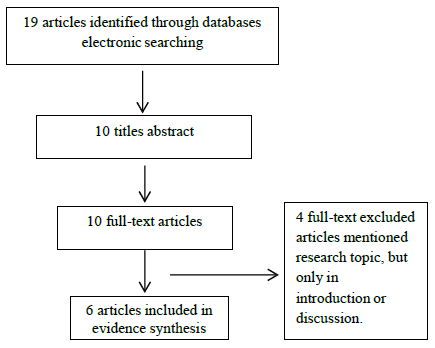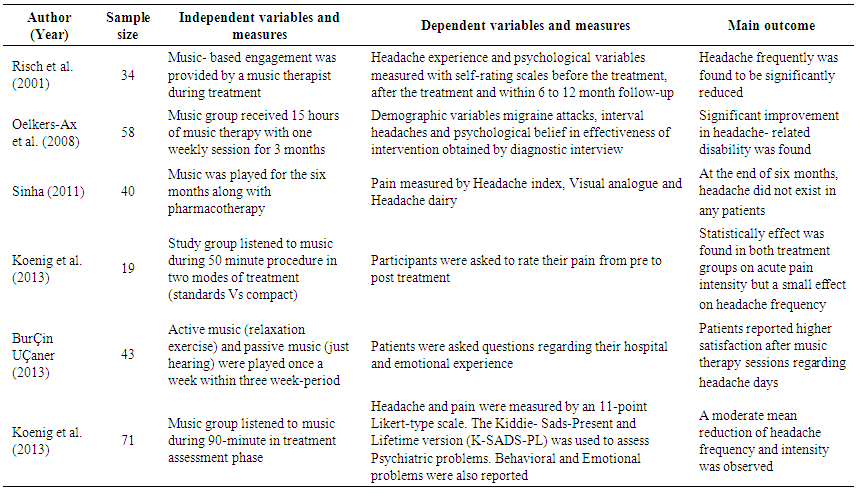-
Paper Information
- Paper Submission
-
Journal Information
- About This Journal
- Editorial Board
- Current Issue
- Archive
- Author Guidelines
- Contact Us
Basic Sciences of Medicine
p-ISSN: 2167-7344 e-ISSN: 2167-7352
2018; 7(1): 7-12
doi:10.5923/j.medicine.20180701.02

Music as a Complementary Approach to Controlling Primary Headache
Sanaz Tajadini1, Hamid Reza Farpour2, Sima Farpour3
1General Linguistics, Ph.D. student, Department of Foreign Languages and Linguistics, Shiraz University, Shiraz, Iran
2Assistant Professor of Physical Medicine and Rehabilitation, Shiraz Geriatric Research Center, Bone and Joint Diseases Research Center, Shiraz University of Medical Sciences, Shiraz, Iran
3MSc of Speech and Language Therapy, Shiraz Geriatric Research Center, Shiraz, University of Medical Sciences, Shiraz, Iran
Correspondence to: Hamid Reza Farpour, Assistant Professor of Physical Medicine and Rehabilitation, Shiraz Geriatric Research Center, Bone and Joint Diseases Research Center, Shiraz University of Medical Sciences, Shiraz, Iran.
| Email: |  |
Copyright © 2018 The Author(s). Published by Scientific & Academic Publishing.
This work is licensed under the Creative Commons Attribution International License (CC BY).
http://creativecommons.org/licenses/by/4.0/

Objectives: Headache is one of the most common complaints in patients due to physical and mental Problems. Music intervention is proven to have an effective role on reducing and tranquilizing pain intensity in patients. To our knowledge, there is a paucity of evidence for the benefit of music therapy in headache management. The objective of this review was to evaluate the use of music as a complementary approach for primary headache control. Method: Five electronic data bases (Pubmed, Scopus, Science direct, EMBASE, and Central) from 2000 to January 2018 were searched using various keywords: “Tension- type headache”, “Migraine”, “Sound therapy”, and “Music therapy” including the word (and) between these words. Studies were included based on the following criteria: (1) the participants were individuals with TTH and migraine headache; (2) studies assessed headache management; (3) studies assessed the effectiveness of music therapy on these two kinds of headaches. Studies were excluded if participants had any type of secondary or other primary headache and music therapy was not evaluated. Results: Search results identified 19 articles. After manual review of abstracts, 6 of these articles met the inclusion criteria. Conclusion: The combined findings of these articles provide support for the use of music as a complementary, cost effective, and noninvasive approach to the routine care of patients with primary headaches, yet more validated scientific research is still required to explore information about the types of music, optimum duration, and dose of the music with best impact on individuals’ treatment. Further researches should address this issue. The findings of this review are expected to have important implications for clinical settings.
Keywords: Pain,Tension-type headache, Migraine, Music therapy
Cite this paper: Sanaz Tajadini, Hamid Reza Farpour, Sima Farpour, Music as a Complementary Approach to Controlling Primary Headache, Basic Sciences of Medicine , Vol. 7 No. 1, 2018, pp. 7-12. doi: 10.5923/j.medicine.20180701.02.
1. Introduction
- Pain is one of the most common complaints and subjective phenomena in patients due to physical and mental Problems. [1] It has serious impact on health status, quality of life, work, social performance and societal costs. [2, 3] Headache is a common type of pain with the most prevalent neurological disorders. [4] It can be subdivided into primary (Tension-type headache, Migraine, and Cluster headache) and secondary headaches which can have their own set of symptoms, reasons and different kinds of treatment. [5]Tension-type headache (TTH)With a focus on Tension-type headache (TTH) as a non-vascular form of primary headaches, it can be said, TTH is attributed to abnormalities in peripheral and central nociceptive systems in combination with environmental and genetic factors that takes place over hours to days. [6] Environmental and psychological factors (depression, anxiety and stress) are indexed for the development of TTH. [7] It has long been recognized that TTH has high socio-economic impact with a life time prevalence in the general population ranging between 30% and 78% in different studies. [8, 9] With respect to middle age groups, TTH remains more prevalent in women (27.1%) than men (25.6%). [10, 11] One survey by Schawrtz and colleagues on the general population in the United States indicated that episodic tension-type headache with an annual prevalence of 38.3% was highly persistent in many patients. [12]Migraine headacheMigraine as a complex neurovascular form of primary headache, typically lasting 4-72 hours, often considerably reduces social activities and quality of life. [13] It is felt an autonomic feature, including nausea, vomiting, and loss of appetite. [14] It is important to note that genetic predilection would be the main reason as a casual factor underlying the migraine headaches. [15] Interestingly, the incidence of migraine in most Western Societies was estimated about 12% of population. [16] Based on three large epidemiological studies, 17.6% of females and 5.7% of males were affected by migraine attacks in the United States. [17] It is sub-classified into common migraine (without aura) and classic migraine (with aura). [18]Music therapyTo manage these headaches with mild to moderate degree, both pharmacological and non-pharmacological preventive therapies are recommended as alternative and complementary treatments, respectively. The provision of complementary therapy (relaxation therapy, cognitive therapy, music therapy, and meditation), as non-invasive, safe, and inexpensive way to reduce symptoms of headache in many people who are reluctant to use traditional treatment methods or concerned about the toxic effects of the medicines, is primarily the domain of the first line treatment. [19-22] Music therapy as one of the oldest and complementary technique is known to have been used with the aim of promoting a mind-body interaction without side effects. [23] Mechanistically, music has a practical role through the entertainment of body rhythms [24, 25], by releasing of endogenous opioids and dopamine, and changing in hormone modulation. [26] Chlan [27] reported salient features of this recovery positive model of medical treatment, it is easy to apply and to use; it is cost-effective; it does not have adverse effects.Subsequently, the influence of music therapy on headaches became the basic of study. In a previous study, music has been shown to have positive role in the treatment of adults with headache. [28] Thus far, in research conducted by Koeing etal [29] to examine the impact of music therapy among patients with chronic painful conditions, it was found that listening to music decreased pain scores.Although aforementioned studies provide important implications regarding the effects of music therapy on headaches, little attention has been paid to especially randomized controlled trial for evaluation possible effects of music on patients with TTH and migraine. The aim of this review paper is to provide an overview on the impact of music therapy as a conservative management for patients with TTH and migraine.
2. Method
- Search StrategyFive electronic data bases (Pubmed, Scopus, Science direct, EMBASE, and Central) from 2000 to January 2018 were searched by applying the following title keyword search terms: “Pain”, “Tension-type headache”, “Migraine”, and “Music therapy”.Inclusion / Exclusion criteriaStudies were included based on the following criteria: (1) the participants were individuals with TTH and migraine headache; (2) studies assessed headache management; (3) studies assessed the effectiveness of music therapy on these two kinds of headaches. Studies were excluded if participants had any type of secondary or other primary headache and music therapy was not evaluated.Data Extraction and AnalysisData extraction was performed on all articles according to inclusion criteria as (1) the participants’ characteristics, (2) headache assessment, and music therapeutic management of headache assessment.
3. Results
- Search results identified 19 articles. After manual review of abstracts, 6 of these articles met the inclusion criteria, [28-33] among which 2 articles [28, 29] were found in the reference list. The protocol of this review is presented as a flow diagram in Figure (1).
 | Figure 1. Flow diagram of the review protocol |
 | Table 1. Evidence table for selected studies |
 | Table 2. Evidence table for selected studies |
4. Discussion
- The experience of headache and its management are major issues in clinical practice. It is prudent to manage headache and relevant problems when they are deemed significant. Some patients may wish to avoid treating their headache with drugs (e.g. analgesics) which can compromise quality of life due to their side effects. Hence, it is a general recommendation to consider the potential adverse effects of pharmacological treatment. Music has been proven as a valuable complementary modality in clinical situations to reduce the frequency and severity of headache, and limit reliance on medications. Music can be effective not only for headache management but also for improvement of quality of life. A reasonable interpretation is that music influences the mind and body with reducing blood pressure, heart rate, stress, depression, and anxiety levels among patients. Additionally, it can decrease high doses of some drugs which most commonly associated with adverse effects. [34, 35] Moreover, being a noninvasive, inexpensive, and non-time-consuming intervention, music provides its specialized using as a complementary technique in a therapeutic setting.To our knowledge, there are not many studies taking into account the effect of music therapy on primary headaches. The mechanisms of the relationship between music therapy and headache problems are not yet fully understood. This first review aimed to improve our understanding of headache disabilities to scrutinize the possible role of music therapy in headache management.The present review study has some limitations. First, some of the included articles had no any balancing factors between control and experimental group, and also there is not enough description of experimental design in some studies. Another limitation, concerns about no mention of reliability and validity for the scales used for assessment of headache and several measures were patients’ self-reported which could have affected some response bias in terms of researchers’ presence. Moreover, it is a limitation that there is allowance of self-selection of music in one study which could potentially have produced a biased change scores. Therefore, to avoid accepting a false hypothesis, enough attention should be paid to these restrictions in future research.It may seem straightforward that there is abundance great number of studies on primary headache management but specific information regarding the relationship between primary headache management and music therapy is scarce. Hence, future studies should consider measurements of headache and music in patients using valid and reliable interventions in order to describe more details of the relationship. Overall, due to the complexity of variety of music experiences (e.g., active music making vs. receptive music listening), [36] further studies are needed to explore the types of music, optimum duration, and dose of the music with best impact on individuals’ treatment. The body of knowledge in this area would benefit to develop strategies to promote headache management of techniques.
5. Conclusions
- By analyzing qualified studies, it can be concluded that music as a simple and straightforward approach has numerous profound effects not only in headache management but also for social effects with having a large emotional component. These effects may have important implementation for the use of music therapy for headache rehabilitation in people needs to be considered carefully.
ACKNOWLEDGEMENTS
- The authors would like to thank Shiraz University of Medical Sciences, Shiraz, Iran, Center for Development of Clinical Research of Nemazee Hospital and Dr. Nasrin Shokrpour for editorial assistance.
 Abstract
Abstract Reference
Reference Full-Text PDF
Full-Text PDF Full-text HTML
Full-text HTML